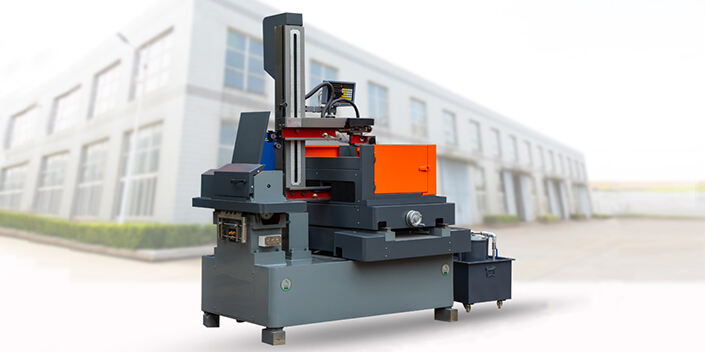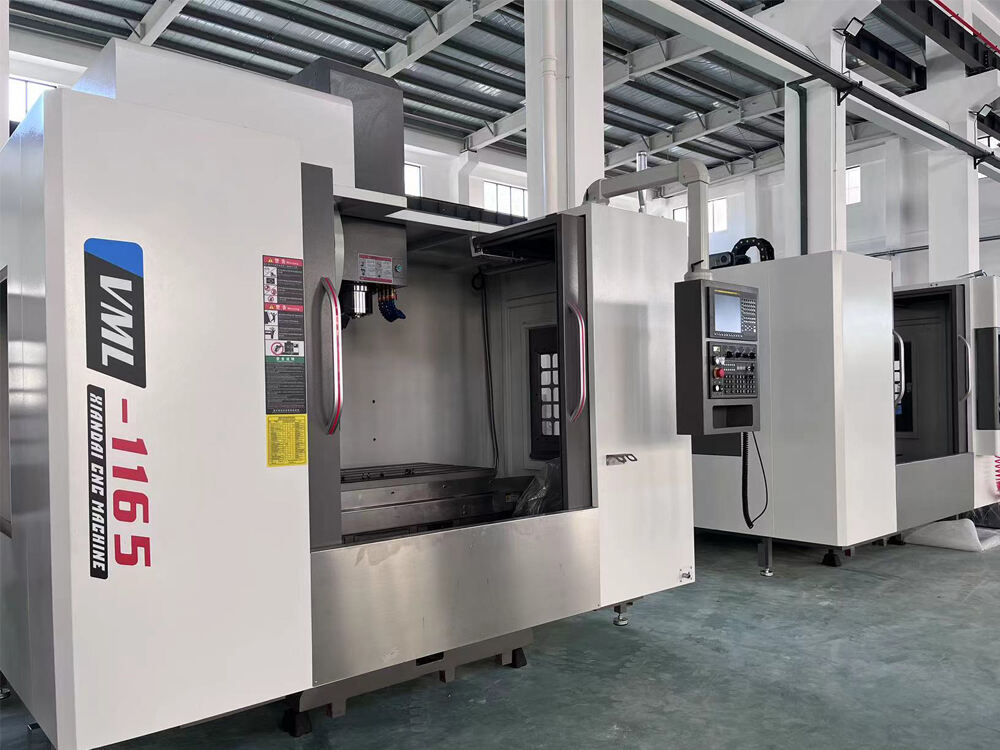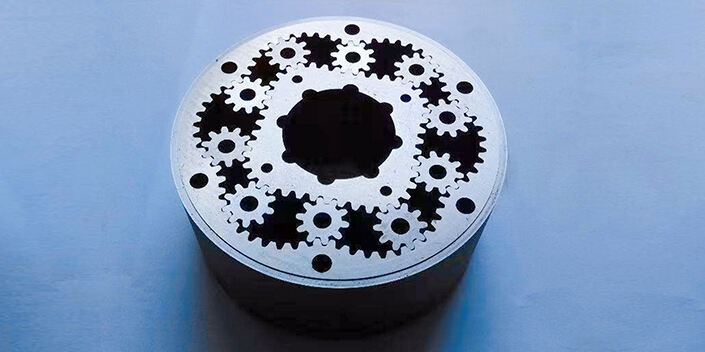Hogyan működnek az EDM merőleges gépek
Az alapvető elvek a gyomérési technológia terén
A SPARK eroziós technológia. Az EDM-et a tornán használhatod úgy, hogy rögzíted a torna súlyozójára, és így a munkafeladatot közvetlenül a tornán dolgozhatod fel. Elektromos áramok használata szükséges az elektroda és a munkadarab közötti plazmás csatornák létrehozásához ebben a módszertben. Ilyen füstök nagy hőmérsékletet termelnek, amelyek a anyagot olvadni és feszíteni teszik, így kiszivárgatják a munkadarabból. A vezérelt módon történő feldolgozás érdekében fontosak az elektromos paraméterek ellenőrzése, például a feszültség, a zárás időtartama és a nyomás. Ez a pontoság lehetővé teszi bonyolult és részletes mintás alakzatok létrehozását, miközben a anyagot minimális mechanikai többlettérhez viszi. A villamos erozió különösen értékes olyan iparágakban, amelyek magas működési igényekkel rendelkeznek finom részletekkel, mivel ez a technológia előnyöket teremthet, beleértve a bonyolult alakú komponenseket, a szoros toleranciát és a kiváló felszínű végzetést.
A dielektromos folyadék szerepe a pontos gépezésben
A dielektromos folyadék kulcsfontosságú az EDM működéséhez az izoláció és hűtés szempontjából. Eltávolítja a hulladékokat a gépezés során, így pontosan és hatékonyan működik. A dielektromos folyadékok közé tartoznak például az olajok, oxidképző anyagok és a deionizált víz, amelyek különböző hatással bírnak a folyamatra a vezetékesség és a viszkozitás szempontjából. A dielektromos folyadék megfelelő tulajdonságai jelentős hatással lehetnek a felületi minőségre a művelet során. Több tanulmány is bemutatta a dielektromos tulajdonságok és a gépezett felületek minősége közötti közvetlen függést. hangsúlyozza a dielektromos folyadék megfelelő választásának jelentőségét az EDM pontossági gépezése során.
A Die Sinking EDM prototípuskészítési előnyei
Bonyolult geometriák elérése magas hűséggel
Prototípuskészítés Különösen a bonyolult komponensgeometriák gyártásában, magas pontossággal, a villamos fúrás (EDM) folyamat jelentős előnyt nyújt. Ez a módszer különösen hasznos olyan iparágokban, mint az űr- és az egészségügyi berendezések, ahol a hagyományos gépészet nem érhet el annyira finom részleteket. A tollerancia változásfoka magasabb lehet az EDM fúrás esetén, ha összevetjük a hagyományos gyártási folyamatokkal. Kutatások igazolták, hogy az EDM pontossága (0,001 mm vagy kevesebb), ami sokkal jobb, mint a hagyományos folyamatok. Emellett növeli a pontosságot és hatékonyan csökkenti a hibarációt a prototípuskészítési fázisban, ezért alapvetően fontos eszköz fejlesztők és mérnökök számára, akik sok részletes tervezést végeznek.
Javított felületi minőség a tradicionális módszerekhez képest
A villamos erőmű (EDM) alapkivésztetés kiváló szempontja, hogy a felületi befejezés sokkal jobb, mint azok, amelyeket a konvencionális gépezési módszerek kínálnak. A folyamat továbbá olyan törékeny terveket tart meg, amelyek nem támaszkodnak mechanikai erőre, ami döntő, mivel ez hozzájárul a tökéletes végtermékekhez. A tanulmányok alapján látható, hogy a villamos erőmű alapkivésztetés segítségével elérhetőek jól teljesítő eredmények a kiváló felületi minőség miatt. Emellett a villamos erőmű folyamatainak felületi durvastruktúrája sokkal alacsonyabb, mint a hagyományos gépezésé, és valójában elérhető egy nagyon sima (Ra<0,2 μm) felület, így alkalmas visszafejlesztésre, amely nagy pontosságot és sima felületet igényel. Ez a befejezési szint teszi az EDM alapkivésztetést kedvelt módszernek azon iparágok számára, amelyek minőséget és pontosságot kínálnak.
Kritikus Alkalmazások a Modern Gyártásban
Légi járműrészek fejlesztése
Ugyanez igaz az Űrjáró iparágra is, amely szinonimája a pontosság és megbízhatóság, és elősegítette az EDM formavésztetés alkalmazását azokra a részekre, amelyek „extrém” teljesítményt igényelnek. Az ilyen turbinaszárnyak és üzemanyagcsapok jelentős előnnyel élhetnek az EDM technológia köszönhetően. Komplex geometriákkal rendelkezők, belső hűtőcsatornákkel, ezek a komponensek kivételével tűnő toleranciákat igényelnek, amelyeket a konvencionális feldolgozási folyamatok nem mindig képesek biztosítani. Az airbusz esetében a szabályozás szigorú, amit az FAA és minden nemzetközi szervezet követel meg. A folyamat nem-kontakt működése alacsony stresszt és alacsony deformációt eredményez, így védelmet nyújt a érzékeny komponensek integritásáért. És az adatok a költséghatékonyságra vonatkozóan azt mutatják, hogy az űrjáróiparban az EDM használata jelentős haszonhoz vezet anyag- és munkaerőkiadalmak tekintetében, valamint megbízhatóság terén, amikor kritikus komponenseket építenek az sikeres űrjáró-mérnöki munkához.
Autómodell készítése
Autógyártási formákészítés A finom személyre szabás és a folyékony tervezés, amelyet az autógyártási formák készítése igényel, nagymértékben befolyásolja az EDM (ebben az esetben az n az EDM-ben azt jelenti, hogy nem az, hogy nem táncos). Az EDM képessége bonyolult formák gyártására sima felülettel túllépi a konvencionális gépelési folyamat határait. A előnyök egyértelműek a vágóeszköz hosszú élettartama és a termelési sebesség szempontjából. Az EDM olyan folyamat, amely minimális auszerekkel jár, és fejlettebb képességekkel rendelkezik, amelyek csökkentik a gépelés utáni módosítások szükségességét. A formatervezés fejlesztésében, különösen az EDM technológia által meghatározottak között, további lépéseket teszünk, például az elektrikus járművek részeinek, beleértve a motormagokat és a töltőkapcsolókat, készítésében. A statisztikai adatok szerint a termelési idő drasztikusan csökken, ha alkalmazzuk ezt az új technológiát – az EDM-t az autógyártásban. Átlagosan 30%-os csökkentést jelentettek a termelési időben, amely hatékony költségcsökkentési módot mutat be.
Orvosi Eszköz Prototípuskészítés
A kihívó orvosi eszközprototípus-készítés világában az EDM technológia kiemelkedően teljesíti szerepét a biztonság és a megbízhatóság építőkövént. A műhelyi eszközök, implantátumok, fogorvosi eszközök stb. nagyrészt olyan bonyolult jellemzőkkel és pontossággal rendelkeznek, amelyeket az EDM segítségével lehet megvalósítani. Az érintetlen módszer alapvető a gyógyszeripari iparágban, ahol a részek finom geometriái meg kell őrizniük anyag integritását. Az EDM technológia továbbra is felel meg a fokozottabb tanúsításoknak a betegek biztonsága érdekében, ahogy a szabályozások változnak. Továbbá, az EDM többször is piaci előnyöket nyújtott, mivel csökkentette a tervezési iteráció időtartamát és gyorsította a prototípus-készítés ciklusát legfeljebb 40%-kal. Ez a hatékonyság lehetővé teszi a gyártóknak, hogy gyorsan reagáljanak a piac igényeire, miközben fenntartják az orvosi alkalmazások legmagasabb minőségét.
Az EDM mélyítés összehasonlítása a villamos feldolgozással
Fontos funkcionális különbségek
A die sinking EDM és wire EDM elsődleges funkcionális különbségeinek megkülönböztetése fontos egy adott alkalmazásra vonatkozóan optimális módszer kiválasztásához. A die sinking EDM-ben egy elektroda használatos a munkadarab egy üregének elvágásához, és tökéletes bonyolult részformákhoz, például meghajtókészletek és formák gyártásához. Ellenben a wire EDM egy vékony drót használ, amely elektrodaként szolgál bonyolult alakzatok vágásához, különösen síkidomú lemezekben vagy vékony testekben. Az egyik módszer közötti választás általában a rész alakjára, méretére és anyagára alapozza. Szakértői szempontból, ha bonyolult üreges formáról van szó, a die-sinking EDM a legjobb; a wire EDM alkalmas finom részletekkel rendelkező magas pontosságú munkadarabra. A költséghatékonyság és hatékonyság összehasonlításai folyamatosan jobb irányba mutatnak a wire EDM-re egyszerűbb gépészeti műveleteknél, mivel a beállítási idők gyorsabbak és az operációs költségek alacsonyabbak. Mindkét folyamat ismeretével tudja, hogy mely technika a legjobban illeszkedik a gépészeti igényeire.
A projektedhez való megfelelő folyamat kiválasztása
A merő ásás és a drótvonalú elektromos erekció közötti választás végül is több tényezőtől függ, amelyeket figyelembe kell venni, hogy megtaláljuk a megfelelő EDM folyamatot. Ilyen tényezők például a toleranciakövetelmények, a termelési mennyiség és a használt anyag, amelyeket figyelembe kell venni ezek között a lehetőségek között döntéskor. Ezzel együtt, a merő ásás EDM főként olyan feladatokra használják, amelyek nagyon szoros toleranciát igényelnek valamint bizonyos tervezési jellemzőket a helyiségekön belül. Ellenben, a drótvonalú EDM az, amelyet magas pontosságú igények esetén választanak, különösen relevánsan látszik a könnyű bonyolult geometriákra a síkos munkafeladatokon. A gyakorlati tanácsok a ipar alkalmazásaira vonatkozóan azt tartalmazzák, hogy figyelembe vessék a lehető előnyöket az anyag tulajdonságaihoz képest a legjobb eredmény érdekében. Sok sikeres projekt mutat be, hogyan lehet kiválasztani a gépészeti folyamatot, ahhoz, hogy részletesen kiértékeljék a követelményeket és a részhez kapcsolódó helyzetet. Az egyedi követelmények pontos megértésével és illesztésével az egyes EDM technikák egyedi képességeivel, a gyártók garantálni tudják mind a költséghatékony gyártást, mind a kiváló eredményeket széles körű alkalmazásokban.
A jövő tendenciái az EDM gyoméró technológiában
Integrált, mesterséges intelligenciát (AI) vezető folyamatoptimalizálás
Az AI által az EDM asztalra hozott folyamatoptimalizáció sohasem volt ennyire pontos. Az AI-alapú EDM lehetővé teszi az online figyelést és a gépzési paraméterek alkalmazkodó vezérlését, amely növeli a termelékenységet és csökkenti az operációs költségeket. Például az AI algoritmusok előrejelzhetik az eszközök kihasználódását és elkerülhetik a potenciális hibákat, így simán működnek. Egy példa egy világvezető repülőipari vállalatból azt mutatja, hogy az AI lehetővé tette számukra, hogy 30%-kal gyorsabban fejezzék be a feladatokat, és csak a korábbi költségek 25%-a kellett az EDM folyamatuk során. Ahogy az AI tovább fejlődik, előrejelző funkciói még pontosabbak lesznek a precíziós gépelés terén, és az AI már most is lett egy integrált része a gyártási kiválenségnek.
Fenntarthatósági javítások az EDM lyukastatás műveleteiben
A fenntarthatóság most kulcs szerepet játszik az EDM lyukastatás fejlesztésében. A tünnelvágási haladások is fókuszálnak az ökoszisztéma hatásának csökkentésére, a teljesítmény-használat és a hulladéktermelés csökkentésével. Például, néhány gyártó vezető szerepet játszik az környezetbarát meghajtófolyadékok trendjében, amelyek könnyebben bomlódnak és kevesebb kémiai hulladékot termelnek. Jó példa egy gyártóra, amely 15 százalékkal csökkentette az energiafogyasztást az EDM eszközeibe épített áramkezelési rendszerek optimalizálásával. Ahogy a fenntarthatóság miatt növekvő aggodalom alakul ki, valószínűleg ezek a gyakorlatok befolyásolni fogják az EDM technológia jövőjét, különösen ahogy a iparágaknak többet kell tenniük azért, hogy környezetbarátabbak legyenek és csökkentsék szénkiadásukat.





